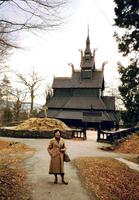You are in: Europe -> Norway -> Urnes Stave Church, and traditional search or Image Gallery will yield results of this site only
Urnes Stave Church
| Site number: | 58 |
|
| Type of site: | Cultural | |
| Date: | 12-13th century | |
| Date of Inscription: | 1979 | |
| Location: | Europe, Norway | |
Up to 75 images are shown here. Click on each for more details or on Image Gallery for more images.
Six official UN languages:
Arabic,
Chinese,
English,
French,
Russian,
Spanish
Other languages: Danish, Dutch, Finnish, Japanese, Norwegian-bokmål, Norwegian-nynorsk, Polish, Portuguese, Swedish
Other languages: Danish, Dutch, Finnish, Japanese, Norwegian-bokmål, Norwegian-nynorsk, Polish, Portuguese, Swedish
| Description: | The stavkirke, the wooden church of Urnes, is positioned in the natural setting of Sogn og Fjordane. This exceptional instance of traditional Scandinavian wooden architecture, built in the 12th and 13th centuries, merges traces of Celtic art, Viking customs and Romanesque spatial structures. --WHMNet paraphrase from the description at WHC Site, where additional information is available. | |
| Urnes stave church (Norwegian: Urnes stavkyrkje) is a stave church at the Ornes farm, near Lustrafjorden in Luster municipality, Sogn og Fjordane county, Norway. In 1979 the Urnes stave church was listed as a world heritage site by UNESCO, where it joins such other famous locations as the Great Pyramid of Giza and Stonehenge. It is owned by Fortidsminneforeningen (Society for the Preservation of Norwegian Ancient Monuments). Masses are occasionally held in the church. The church was built around 1130 or shortly thereafter, and still stands in its original location. The church is believed to be the oldest of its kind. It provides a link between Christian architecture and the architecture and artforms of the Viking Age with typical animal-ornamentation, the so called "Urnes-style" of animal-art. Archaeological investigations have discovered the remains of one, or possibly two, churches on the site prior to the current building. The excavations uncovered holes in the ground from earth-bound posts which had belonged to an early post church, a type of church with walls supported by short sills inserted between free-standing posts. It is not known if this church had a raised roof above the central space of the nave like the present church. The earliest possible dating of this church is the early 11th century. The portal and other details of the north wall of the present church, as well as the wall planks of the gables, are decorated in classic Urnes-style. They are probably relics from one of the earlier churches. It has been speculated that the portal may originally have been the main portal, facing west. There have been numerous attempts to interpret the decoration (iconography) of the church's most remarkable part, the old portal in the northern wall. The images are generally considered to represent a snake curling upwards. At the lower end there is an animal with four feet biting the snake. A common interpretation of this scene is that it portrays the eternal fight between good and evil. The animal is widely believed to be a stylised lion. In Christian iconography the lion is a symbol of Christ, fighting the evil symbolized by the snake, a common representation of Satan. --Wikipedia. Text is available under the Creative Commons Attribution-ShareAlike License. | ||
| Source: | http://whc.unesco.org/en/list/58 | |
| Reference: | 1. UNESCO World Heritage Center, Site Page. | |





















